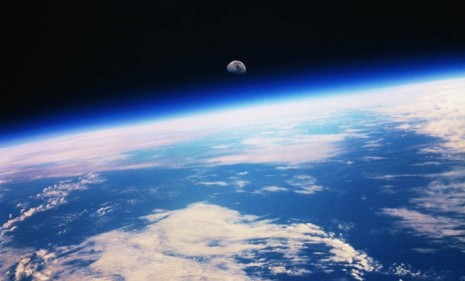Did Earth have two moons?
Some astronomers believe our moon had a smaller sibling for 80 million years — before it was destroyed in a violent collision

The moon once had a smaller sibling, according to astronomers from the University of California, Santa Cruz. The researchers used computer models to simulate the size, orbit, and ultimate destruction of the second moon that they believe once shared the night skies above our Earth. But what became of our second moon? Here, a brief guide to the new theory:
Where did the second moon come from?
Astronomers believe the second moon was created the same way as our current moon: A Mars-sized planet crashed into Earth, kicking up an enormous ring of debris that orbited our world. Over time, this debris coalesced into our existing large moon, as well as a second, smaller moon. The two satellites co-existed peacefully in the sky for some 80 million years, looking like siblings. They were the same color and shape, though our moon was three times larger than the other.
The Week
Escape your echo chamber. Get the facts behind the news, plus analysis from multiple perspectives.

Sign up for The Week's Free Newsletters
From our morning news briefing to a weekly Good News Newsletter, get the best of The Week delivered directly to your inbox.
From our morning news briefing to a weekly Good News Newsletter, get the best of The Week delivered directly to your inbox.
What happened to our second moon?
About 4.5 billion years ago — before there was even life on Earth — the second moon hit our existing moon in a dramatic, slow-motion collision occurring over several hours. Because the smaller moon was more solid than the still-molten surface of our larger moon, the collision resulted in a "splat" that scattered wrecked pieces of the smaller moon all over the larger moon's far side. That helps to explain why the two sides of our moon are so different.
What's different about the two sides of the moon?
The side facing Earth is relatively smooth and flat, whereas the far side of the moon, which never faces the Earth, is rugged, mountainous, and pockmarked with craters. Astronomers speculate that the force of the impact of the smaller moon was responsible for creating much of the far side's rocky, debris-strewn landscape.
A free daily email with the biggest news stories of the day – and the best features from TheWeek.com
Are scientists certain this happened?
No. Like any new theory, this one is speculative, and some astronomers are already finding holes in the theory. It doesn't explain, for example, why the ragged landscape of the moon's far side has a much higher concentration of aluminum than the near side. (Both moons would have been made of the same material.) A NASA lunar mission scheduled for launch this September, the Gravity Recovery and Interior Laboratory, or GRAIL, may help to confirm (or debunk) this new theory.
Sources: Associated Press, International Business Times, Nat. Geo., Scientific American
-
 The Week’s big New Year’s Day quiz 2026
The Week’s big New Year’s Day quiz 2026Quiz of the Year How much do you remember about 2025’s headlines? Put yourself to the test with our bumper quiz of the year
-
 Is tanking ruining sports?
Is tanking ruining sports?Today's Big Question The NBA and the NFL want teams to compete to win. What happens if they decide not to?
-
 ‘Netflix needs to not just swallow HBO but also emulate it’
‘Netflix needs to not just swallow HBO but also emulate it’instant opinion Opinion, comment and editorials of the day